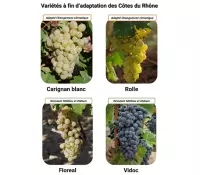VIFA: 4 new grape varieties under trial in the Côtes du Rhône
As of autumn 2024, four new grape varieties are part of the “cahiers des charges” (specifications) of AOCs Côtes du Rhône and Côtes du Rhône Villages: they are known as VIFA, or “Varieties of Interest for Adaptation Purposes” (in French: Variétés d’Intérêt à Fins d’Adaptation).
This acronym refers to a procedure that allows appellations to adapt to current challenges, such as climate change or reducing the use of phytosanitary products (such as fungicides), by testing new grape varieties in real-life conditions. The trials take place over ten years, during which the varieties are closely monitored, with strict limitations (maximum 5% of an estate’s area under vine, maximum 10% in a blend). At the end of trial period, the appellation decides whether to officially approve or reject the varieties. (More information on this procedure)
For AOCs Côtes du Rhône and Côtes du Rhône Villages, 4 varieties have therefore been added of the existing lists of respectively 23 and 20 grape varieties. They are: Carignan blanc, Floréal, Rolle (also known as Vermentino), and Vidoc.

Contents
Carignan blanc
This grape variety is a mutation of Carignan noir, which has long been authorized both in Côtes du Rhône and in Côtes du Rhône Villages. Like its counterpart, it tolerates drought well, but it is sensitive to powdery mildew. It brings freshness to wines, a moderate level of alcohol, and aromas of flowers and white fruits.
Floréal
Technically, Floréal is an interspecific hybrid, the genetic child of two varieties from different species (while usual varieties – “cépages” in French – derive solely from Vitis vinifera). It was created by INRAE, in France, as part of a research program focused on disease-resistant vines. Floréal is resistant to powdery mildew and downy mildew, allowing for reduced use of phytosanitary treatments in the vineyard, a major advantage in peri-urban areas, near residential zones.
In wine, Floréal contributes a highly expressive aromatic profile, with notes of white flowers and tropical fruits, along with a pleasant freshness on the palate.
Rolle
Better known as Vermentino (or Vermentinu), this Italian grape is called Rolle under French regulations. It is already authorized in Rhône Valley appellations such as Luberon and Costières de Nîmes, and has now been introduced to Côtes du Rhône and Côtes du Rhône Villages as a VIFA. Well-suited to warm and sunny climates, Rolle is an asset in the context of climate change. In wines, it brings refreshing citrus notes, almond, floral and fresh fruit aromas, along with good balance on the palate.
Vidoc
The only black grape variety of this list, Vidoc is also a hybrid, like Floréal. Developed by INRAE from a cross with Regent, it was selected for its good resistance to downy and powdery mildew, and, to a lesser extent, to grey rot. In a wine, Vidoc contributes firm tannic structure and deep color, along with spicy notes. It is especially promising for rosé winemaking.
The VIFA stats does not allow winemakers to list these varieties on the bottle, whether on the label or on the back label, even if they are part of the blend. Who knows: perhaps you have already tasted a wine crafted with a VIFA grape?!


